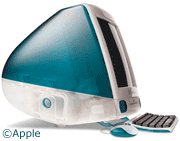The iBook was announced almost
five months ago and has been relatively available since late
September. Are we about due for a Revision B iBook?
Lets look at Apple's other consumer computer for some hints.
- The original iMac was
announced on May 6, 1998. It was available on August 15,
1998.

- The iMac/B replaced it in
mid-October 1998, after just two months on the market. Improvements
included an improved graphics chip, more VRAM, and OS 8.5.
- The iMac/C replaced the /B in
January 1999, after less than two months on the market. This model
boosted speed from 233 to 266 MHz, had a 50% larger hard drive
(from 4 GB to 6) and came in five "flavors."
- The iMac/D replaced the /C
on April 14, 1999 - just a bit more than three months after the /C
was introduced. The new feature was still more speed (333
MHz).
- Five-and-a-half months later, Apple introduced Kihei, the new
iMacs. They had a new case, a faster system bus, better graphics,
more VRAM, twice the memory (64 MB), and even a version with DVD
and FireWire.
The basic iMac ran at
350 MHz; the DV at 400 MHz.
What can we learn from this? First, that Apple believes in
ongoing upgrades for consumer computers. On average, the iMac is
revised every four months. That's three revisions per year.
If the same standard applies to the iBook, and it may not, we
can expect a new model (or at least a noteworthy revision) at
Macworld Expo San Francisco in early January.
What can we expect?
- More memory? RAM prices are finally coming down. Any revision
of the iBook should have 64 MB of memory - enough to run OS 9
without resorting to performance robbing virtual memory.
- More speed? I don't think it's necessary, but then I'm pretty
content with my G3/250 at home and G3/300 at work. For a consumer
machine, this is adequate. However, megahertz does count when marketing
the computer. Because of this, it would be wise to increase speed
to at least 366 MHz - about the same clock speed as the low end
Celeron machines.
- Bigger hard drive? I only recently put a second drive in my
main computer at home. I was getting close to filling the 2.1 GB
drive that came with it. I think 3.2 GB is a lot, but from a
marketing standpoint, it's minuscule. Expect at least a 4 GB drive,
and possibly 6 GB.
- DVD? Don't count on it. However, don't rule out a CD-ROM drive
with better specs. I'd love to see a 52X True-X drive
that would toast anything the Wintel world has to offer. Slot
loading would be nice, since it means less exposure of the
mechanism, but it isn't essential. A better CD-ROM spec is, again
primarily because of marketing.
- FireWire? I wouldn't hold my breath. It would be great, but
Apple may hold onto this card for a future revision. You can rest
assured that at some point the iBook will have FireWire.
Remember that this is a consumer computer which Apple would love
to sell for $100-200 less. To date, they have been stymied by
memory prices, but that's changing.
I do not expect to see any changes in the iBook case, with the
possible exception of a slot-loading CD-ROM drive and maybe a
graphite color scheme (we can hope!). After all, Apple needs to
recover the design costs that went into the iBook's rugged
case.
Of course, I expect some surprises from Apple. The original iMac
was a surprise. Immediate availability of the Blue G3 and some
versions of the G4 was another pleasant surprise. Even the iBook
itself, after all the speculation, surprised us in many ways.
Expect Apple to do the same in January when it is very likely to
announce a new PowerBook and a revised iBook.


